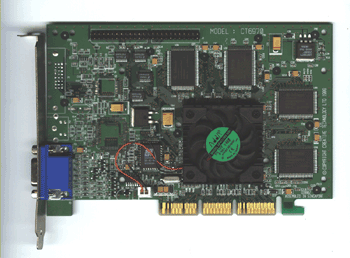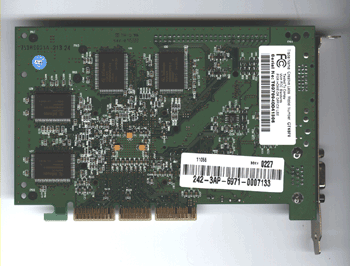
Original Link: https://www.anandtech.com/show/489
Creative Labs 3D Blaster Annihilator Pro GeForce DDR
by Matthew Witheiler on February 23, 2000 12:08 PM EST- Posted in
- GPUs
 It
cannot be denied that Creative Labs is one of the most influential computer
component manufacturers. With products ranging from CD-ROM drives to video cards,
Creative's wide product distribution and placement on almost every store's shelf
make Creative Labs a computer component powerhouse. Well established in the
video card market, Creative Labs originally used the new NVIDIA GeForce processor
and SDR memory design in the 3D Blaster Annihilator. It was not long, however,
before Creative Labs realized something that got other manufacturers thinking:
why make an SDR GeForce card when DDR RAM only costs about 3% more to make?
While currently RAM producers are selling DDR RAM for a premium due to its high
demand, Creative Labs speculated that it would not be long before the price
of DDR RAM compared to SDR RAM only reflected the 3% manufacturing cost. With
this idea came the death of the 3D Blaster Annihilator and the birth of the
3D Blaster Annihilator Pro: a DDR GeForce card.
It
cannot be denied that Creative Labs is one of the most influential computer
component manufacturers. With products ranging from CD-ROM drives to video cards,
Creative's wide product distribution and placement on almost every store's shelf
make Creative Labs a computer component powerhouse. Well established in the
video card market, Creative Labs originally used the new NVIDIA GeForce processor
and SDR memory design in the 3D Blaster Annihilator. It was not long, however,
before Creative Labs realized something that got other manufacturers thinking:
why make an SDR GeForce card when DDR RAM only costs about 3% more to make?
While currently RAM producers are selling DDR RAM for a premium due to its high
demand, Creative Labs speculated that it would not be long before the price
of DDR RAM compared to SDR RAM only reflected the 3% manufacturing cost. With
this idea came the death of the 3D Blaster Annihilator and the birth of the
3D Blaster Annihilator Pro: a DDR GeForce card.
With a large advertising budget and market share, Creative Labs entered the GeForce market with a force. Not only was the 3D Blaster Annihilator Pro one of the first DDR cards on the market, it was also the first one to see its way into the local retailers hands. By holding shelf space in popular stores such as Best Buy and CompUSA, Creative Labs almost ensured its success. It was not long, however, before other video card manufacturers entered the GeForce DDR race. How does the 3D Blaster Annihilator Pro compare to other DDR cards which can take weeks to mail order? Let's begin by looking at the specs.
Specifications (courtesy of Creative Labs)
- Architecture Highlights
256-bit graphics architecture
32MB high-performance DDRRAM
350 MHz Palette-DAC
AGP 4X with Fast Writes Peak fill rate of 480 million bilinear filtered, multi-textured pixels and more than 3.8 gigatexels per second
Up to 15 million triangles per second at peak rates
Integrated transform, lighting, setup and rendering engines
Four 32-bit 3D rendering pipeline 4 texture mapped, lit pixels per clock cycle
Single pass multi-texturing support (DirectX®6.X and OpenGL® ICD)
- 3D Features
Transform and Lighting (T&L) Engine Graphics performance scale with Graphics Processor Unit (GPU) not CPU
Render with geometry instead of texture
Four rendering pipelines capable of delivering four pixels per clock
Cube environment mapping in hardware, fully supported by DX7 and OpenGL
Complete DirectX 7 support 100% hardware triangle setup
Texture Blend support: Multi-texture Bump map, Light maps, Reflection maps, Detail textures
Backend blend 32-bit ARGB rendering with destination alpha Point sampled, Bilinear, Trilinear and 8-tap Anisotropic filtering
Per pixel perspective correct texture mapping: Fog, Light, Mip mapping
Full scene, order independent anti-aliasing 32-bit Z and stencil buffer
- 2D Features
Hardware acceleration for all Windows GDI operations
Fast 32-bit VGA/SVGA support
Multi-buffering (up to quad buffering) for smooth animation and video playback
- Video Support
Video Acceleration for DirectShow and, MPEG1, MPEG-2 and Indeo
X and Y smooth up and down scaling with filtering
Per-pixel color keying
Multiple video windows with hardware color space conversion and filtering (YUV 4:2:2 and 4:2:0)
Video port supports ITU- R 656
- Card Specifications
AGP 4X with Fast Writes
VESA DDC 2B + DPMS
Single slot 2D, 3D graphics, and video accelerator
NVIDIA GeForce256
Classic graphics engine
Integrated 350MHz RAMDAC supporting up to 2048X1536 in true color
MPEG1, MPEG2 and full-motion video
Motion Compensation for MPEG-2 decoding
Full Plug and Play compliant Drivers Windows 95 and 98 display driver (DirectDraw, Direct3D)
Drivers for Windows NT40 (DirectDraw)
OpenGL ICD for Windows 95 and NT 4.0
VBE 3.0 compliant
|
Max Refresh Table |
||
|
Resolution |
Color Depth (BITS) |
Max Refresh Rate (Hz) |
|
640 x 480 |
8/16/32 |
240/240/240 |
|
800 x 600 |
8/16/32 |
240/240/240 |
|
1024 x 768 |
8/16/32 |
240/240/200 |
|
1152 x 864 |
8/16/32 |
200/200/170 |
|
1280 x 960 |
8/16/32 |
170/170/150 |
|
1280 x 1024 |
8/16/32 |
170/170/170 |
|
1600 x 900 |
8/16/32 |
150/150/120 |
|
1600 x 1200 |
8/16/32 |
120/120/100 |
|
1920 x 1080 |
8/16/32 |
100/100/85 |
|
1920 x 1200 |
8/16/32 |
100/100/85 |
|
1920 x 1440 |
8/16/32 |
85/85/75 |
|
2048 x 1536 |
8/16/32 |
75/75/60 |
As we have seen with many companies attempting to place a DDR on the market early, Creative Labs choose to use the NVIDIA reference design when producing the 3D Blaster Annihilator Pro. By doing this, Creative Labs not only keeps their costs and production time down (due to the fact that not much research and development is involved) but also allows them to produce a stable card. The down side of using such a production model is the fact that this leaves the 3D Blaster Annihilator Pro almost indistinguishable from the rest of the DDR card pack. It seems that many manufacturers are taking this path, as is displayed by the fact that of the DDR cards reviewed at AnandTech only ASUS offers a non-reference design board.
As is common with other reference design boards, the GeForce GPU is cooled via the commonly found low profile fan and heatsink. The heatsink is then attached to the GPU with thermal glue, a cooling setup that we do not normally consider ideal when compared to the thermal grease used by other manufacturers. We would suspect that thermal glue and a low profile generic heatsink/fan stack would prove to be fine at the stock core speed of 120 MHz but that the card would not excel at overclocking. Much to our surprise, in the case of the 3D Blaster Annihilator Pro this does not turn out to be the situation; more about this is described in the overclocking section.
Finally are the DDR RAM chips used on the 3D Blaster Annihilator Pro. Like every other DDR GeForce that has found its way into the lab, the 3D Blaster Annihilator Pro uses 6 ns Infineon DDR SGRAM chips.
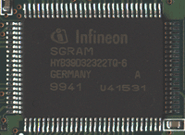 |
The way that the heatsink is pressed against the GPU makes for huge differences in overclocking potential. Normally, we would consider using thermal glue to attach a heatsink and fan to the GeForce GPU an inefficient method of heat dispersion. Thermal grease is usually preferred as the cooling compound of choice due to its high heat transfer rate. Thermal glue, as we have found in the past, tends to trap the heat more, thus resulting in a card that is not as overclockable. The 3D Blaster Annihilator Pro, which uses thermal glue to hold the heatsink onto the GPU, threw our normal conventions askew. With its low profile generic fan and heatsink attached to the GeForce processor with thermal glue, the 3D Blaster Annihilator Pro was able to reach an unparalleled speed of 160 MHz in the core.
The results of overclocking the 3D Blaster Annihilator Pro are quite unprecedented, not only for cards using thermal glue but even for cards using thermal grease. The most likely reason for the high overclocking success found in the 3D Blaster Annihilator Pro is the quality of the GeForce processor. There are two main enemies to overclocking: heat and purity. The first seems to be sufficiently dissipated by the heatsink and fan, resulting in a overclocked temperature that can be tolerated by the GPU. The later, chip purity, is often the reason that variation is found between identical products. Similar to the reason that RAM can not be overclocked indefinitely (as they do not produce much heat), the quality of the silicon used to manufacture the processors also dictate overclockablity. Some sheets are just more pure than others, resulting in different overclocking potential in the GeForce chips. There is no way to tell which chips are a better yield, but at least with the 3D Blaster Annihilator Pro you know that heat will not cripple your overclocking potential by any large amount.
The other side to overclocking is the RAM. With a stock speed of 300 MHz reached by running the DDR chips at 150 MHz each, almost every DDR card can improve upon the memory clock. This is due to the fact that the 6 ns DDR SGRAM chips used are rated to run at 166 MHz each, resulting in a 333 MHz memory clock speed. As we have seen in almost every other DDR card, the 3D Blaster Annihilator Pro was able to reach a maximum memory clock speed of 345 MHz before stability decreased. Due to the fact that every DDR card we have seen uses Infineon 6 ns SGRAM chips, it is no surprise that the RAM performs almost identically regardless of the card.
Something we do not see very often anymore are unique drivers for GeForce based cards. Back a few years ago, reference driver sets were much less common and companies often put the time and effort into making a unique and functional driver set. It seems that with NVIDIA's latest line of processors manufacturers are less eager to produce their own drivers. Rather than spend the time and money to design drivers for a card that will most likely be replaced in 6 months by a newer one (due to the 6 month cycle that NVIDIA is on), many companies chose to use NVIDIA's reference driver set as the basis for their drivers. While this saves money in the long run, it also decreases from the functionality and uniqueness of a card.
With the 3D Blaster Annihilator Pro, Creative Labs chose to take the road less traveled by producing the Creative Blaster Control utility. This unique driver set is unlike anything we have seen in GeForce cards thus far, as it includes many of the reference driver features as well as a few additions. The taskbar utility provides quick and easy access to commonly used features, allowing the user to change from one color setup to another in two mouse clicks. The Direct3D and OpenGL settings include a few additional setting tweaks that may result in better game play, depending on the game. These features include setting texture alignment and texture cache size. The color adjustment screen comes in very handy, especially because Blaster Control comes with preset color schemes, allowing easy transfer from "movie" to "DirectX" color settings. Also in this set is a virtual desktop tool that allows you to set a desktop resolution higher than what your monitor is actually displaying. By moving your cursor in the direction you wish to move the screen, the desktop actually slides over to that side and reveals that which can not be seen in the lower resolution. This feature is nice to play with from time to time, but its true usability can be debated. Finally, the Blaster Control utility comes with a memory overclock utility that allows the user to change the default memory speed via a slider. This is a great asset to any driver set because it eliminates the need for a third party utility to perform the task. The Blaster Control does lack a core speed adjuster, meaning that using the utility alone will not allow for a full overclock. To adjust this setting, it is necessary to download a third party application. While this may be safer from Creative's point of view, it leaves the user tempted by the included memory overclocking utility and desiring a core overclocker.
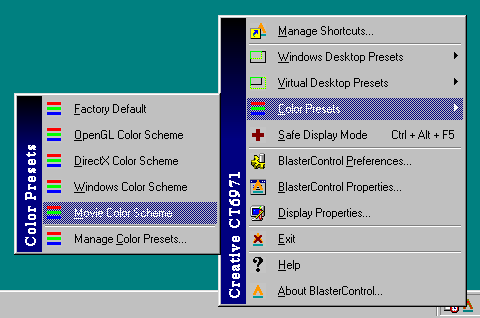
The taskbar utility allows for on the fly tweaking.
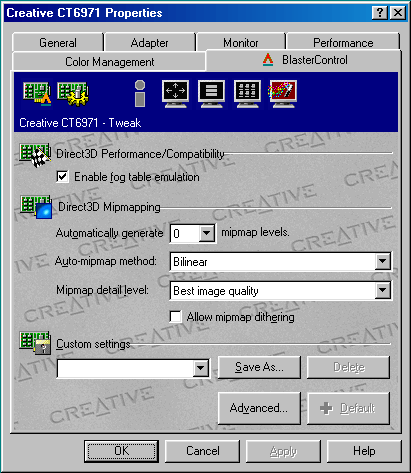
Direct3D Features in the basic screen are the same as those found in the reference
drivers.
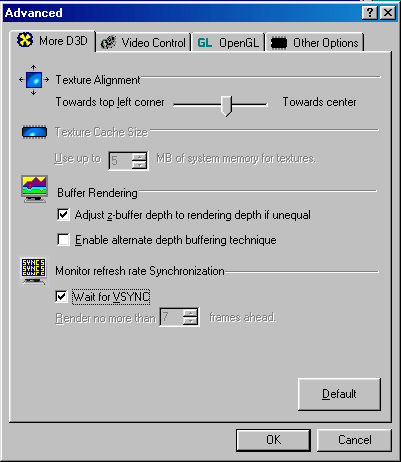
In the advanced screen, more advanced Direct3D settings are present.
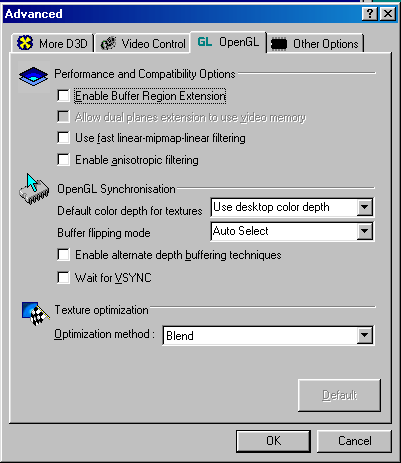
OpenGL settings can also be altered.
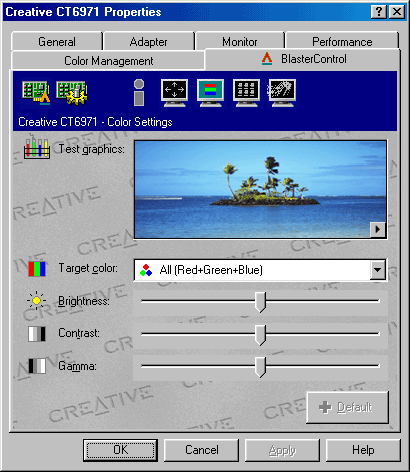
Color settings are easy to find and adjust.
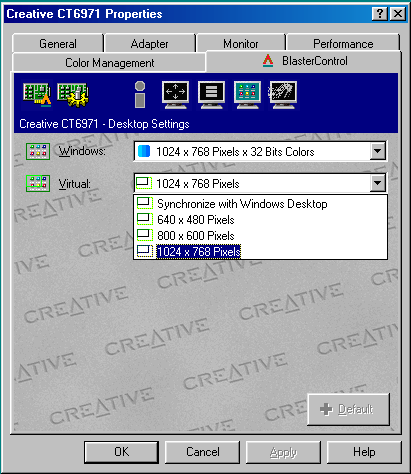
Virtual desktop allows you to view higher resolutions in more detail.
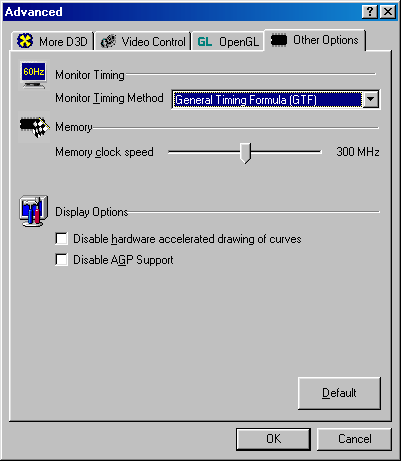
The memory clock speed is easily adjusted via the slider bar.
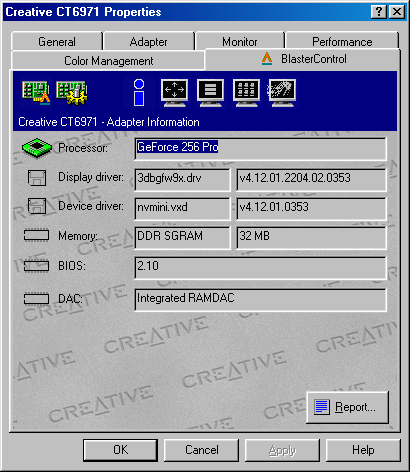
The information screen displays all vital facts.
|
|
Windows
98 SE Test System
|
|
|
Hardware
|
|
CPU(s) |
Intel
Pentium III 550E |
| Motherboard(s) |
ABIT
BF6
|
| Memory |
128MB PC133 Crucial Technology SDRAM |
| Hard Drive |
Quantum Fireball CR 8.4 GB UDMA 33 |
| CDROM |
Acer 24x |
| Video Card(s) |
Creative Labs 3D Blaster Annihilator Pro |
|
|
Software
|
|
Operating System |
Windows 98 SE |
| Video Drivers |
|
|
|
Benchmarking Applications
|
| Gaming |
GT
Interactive Unreal Tournament 4.04 UTbench.dem |
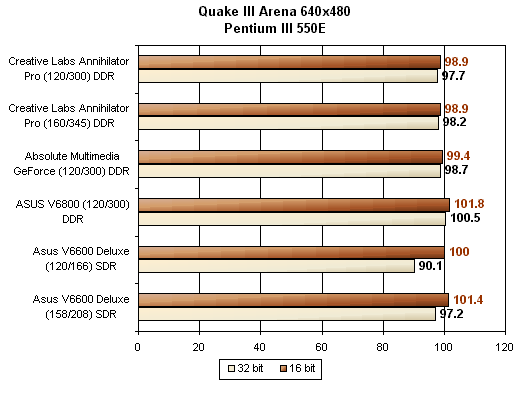
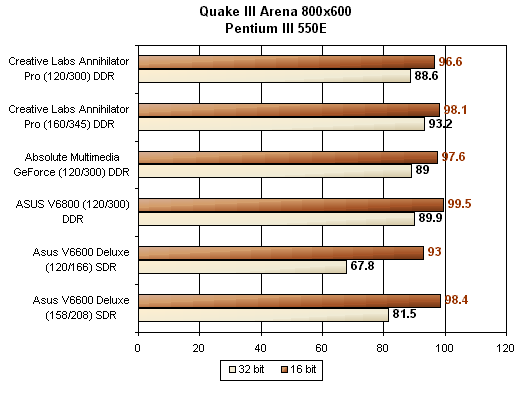

As can be seen in the above Quake III FPS graphs, at stock speed the Creative Labs 3D Blaster Annihilator Pro performs on par with other DDR GeForce cards. Since many of the DDR cards are using the reference design, the performance difference between the 3D Blaster Annihilator Pro and other DDR cards is expected to be small. It is when the 3D Blaster Annihilator Pro is overclocked that we see a large performance gain. Reaching a maximum speed increase of 19% when in 1024x768x32, the speed of the 160/345 MHz card really pays off.
Also seen in the above graphs is the difference between one of our best performing SDR cards and various DDR cards. At first the difference is small, due to the fact that Quake III Arena can only use so much of the GeForce's potential when at such low resolutions. The difference, however, become larger with higher resolutions and colors. In fact, the stock clocked Creative Labs 3D Blaster Annihilator Pro performs 48% better than the stock clocked SDR card at 1024x768x32. When the 3D Blaster Annihilator Pro is overclocked, this difference jumps to a large 77%.
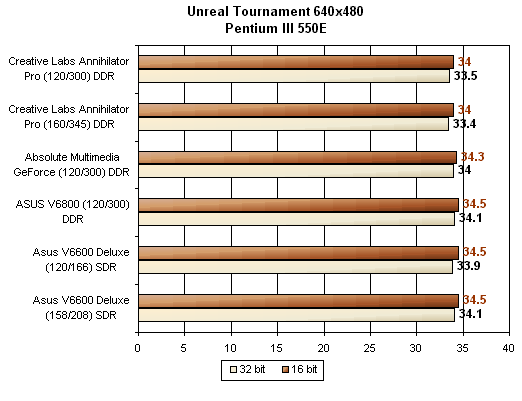
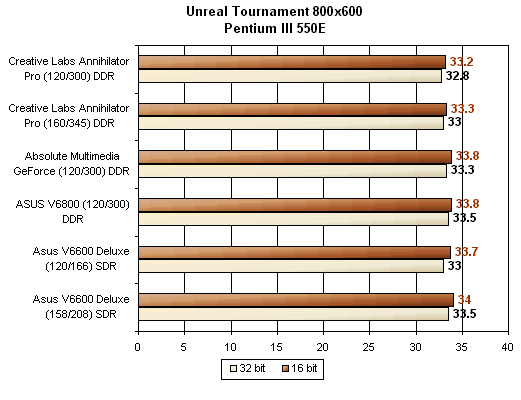
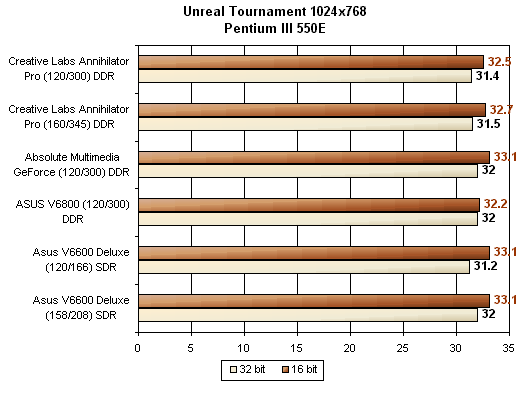
As noted in the past, the speed of the GeForce appears to overwhelm the Unreal Tournament engine, as DDR cards perform the same as SDR cards and overclocked cards perform the same as those at stock speeds. It seems that the Unreal engine was originally written to take advantage of the CPU speed and not the graphics card because at the time the engine was written the graphics processor was rather weak. Now, with the advancement in 3D gaming and fast video processors, Unreal Tournament is unable to take advantage of the speed differences between the cards. This leaves us with a graph that looks nearly identical no matter which card is being examined.
Many of the DDR based GeForce cards on the market are almost indistinguishable from one another. Many contain the same features, options and rarely differ in quality. Creative Labs, however, stands a bit out of the pack due to its high availability, fast overclocked speeds, and unique driver set. First, let's examine the features of the card which make it unique.
What the 3D Blaster Annihilator Pro lacks in originality of board design, it makes up for with efficient cooling. It is always a pleasant surprise to have a card outperform its predecessors and Creative Labs did not disappoint. Also noteworthy is the fact that the reference design, even though it lacks some of the advanced features found on non-reference boards, cuts the cost and enhances the roll out time of a card. It was a bit surprising to find that Creative Labs did not include any TV-out support, a feature commonly found in DDR boards of this price. If you want to use the included WinDVD DVD decoder software to display DVD movies on your television, you are out of luck. The 2D quality of the board was fine at resolutions as high as 1600x1200, meaning that even larger monitors will be able to take advantage of the 3D Blaster Annihilator Pro's DDR power.
The fact that Creative Labs chose to produce their own driver set from the ground up is a nice feature. Rather than see the same recycled driver features over and over again, Creative's use of proprietary drivers allow for enhanced ease of use and functionality. The software bundle decent when compared to the competition. Rather than package the same no-name games found in many video cards, Creative Labs actually included the rather popular Need for Speed 4: High Stakes game by Electronic Arts. However, Creative could not resist throwing in the standard useless games such as Dagoth Moor Zoological Gardens, Evolva: Scout, Colorific, and the standard demo package. At least you get one useful game in the package. Also included is WinDVD, a software based DVD decoder. This software was an interesting choice for Creative Labs, as it is usually found in cards with video-out (a feature which the 3D Blaster Annihilator Pro lacks).
The one thing that sets the 3D Blaster Annihilator Pro apart from the rest of the DDR cards is the fact that it is produced by a hardware powerhouse: Creative Labs. When you walk into a Best Buy or a CompUSA, you do not expect to see a Gigabyte card on the shelf. You are almost assured, however, that a Creative Labs card will be there (as long as it is not sold out). This provides a significant advantage to users who want to buy from a company they know, do not want to deal with the hassles of mail order, or simply want a DDR card right away. These facts alone justify its somewhat pricey $270 price tag. The 3D Blaster Annihilator Pro makes perfect sense in these cases, as the card performs well and has a very good overclocking potential. With the 3D Blaster Annihilator Pro, Creative Labs continues to dominate the retail hardware market.

